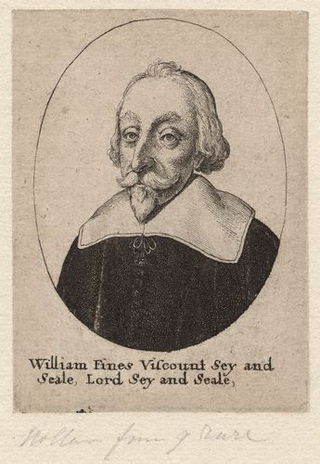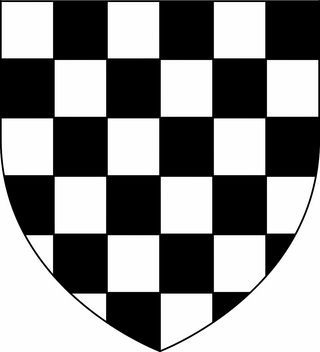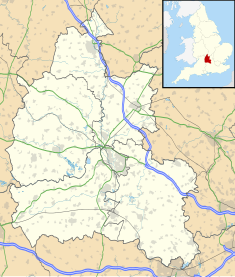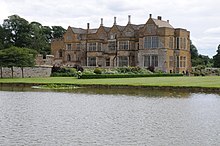
Hever Castle is located in the village of Hever, Kent, near Edenbridge, 30 miles (48 km) south-east of London, England. It began as a country house, built in the 13th century. From 1462 to 1539, it was the seat of the Boleyn family.

Baron Saye and Sele is a title in the Peerage of England held by the Twisleton-Wykeham-Fiennes family. The title dates to 1447 but it was recreated in 1603. Confusion over the details of the 15th-century title has led to conflicting order for titleholders; authorities such as Burke's Peerage and Debrett's Peerage do not agree on whether or not the 1447 creation is still extant.

William Fiennes, 1st Viscount Saye and Sele was an English nobleman and politician. He was a leading critic of Charles I's rule during the 1620s and 1630s. He was known also for his involvement in several companies for setting up overseas colonies.

Shutford is a village and civil parish in the Cherwell district, in Oxfordshire, England, about 4.5 miles (7.2 km) west of Banbury. The village is about 475 feet (145 m) above sea level. In 2011 the parish had a population of 476. In 1870–72, John Marius Wilson's Imperial Gazetteer of England and Wales described Shutford like this:

Broughton is a village and civil parish in northern Oxfordshire, England, about 2+1⁄2 miles (4 km) southwest of Banbury. The 2011 Census recorded the parish's population as 286.
Susannah Hersey Fiennes is a British artist who has worked extensively with King Charles III and is collected in Europe, Asia and America.
Nathaniel Thomas Allen Fiennes, 21st Baron Saye and Sele,, styled as Lord Saye and Sele, was an English peer, businessman, chartered surveyor and army officer.
Geoffrey Cecil Twisleton-Wykeham-Fiennes, 18th Baron Saye and Sele was an English soldier and Liberal politician from the Twisleton-Wykeham-Fiennes family. He served as Comptroller of the Household between 1912 and 1915.

John Fiennes was the third son of Puritan noble and politician William Fiennes, 1st Viscount Saye and Sele. He served in the Parliamentarian army during the First English Civil War, before resigning his commission when elected MP for Morpeth in 1645. Excluded from Parliament by Pride's Purge in December 1648, he largely avoided politics thereafter but was appointed to Cromwell's Upper House in 1658.
Oliver William Twisleton-Wykeham-Fiennes was Dean of Lincoln in the latter part of the 20th century.
William John Fiennes FRSL is an English author best known for his memoirs The Snow Geese (2002) and The Music Room (2009).

James Fiennes, 2nd Viscount Saye and Sele was an English peer and MP at various times between 1625 and 1660, when he succeeded his father and entered the House of Lords.
The Venerable Frederick Fiennes, 16th Baron Saye and Sele, MA (1799–1887) was Archdeacon of Hereford from 1863 to 1887.
Sir Roger Fiennes (1384–1449) was an English knight of the shire, High Sheriff of Surrey and Sussex, and builder of Herstmonceux Castle. He was also Treasurer of King Henry VI's household.
Richard Fiennes, 7th and 1st Baron Saye and Sele was an English peer and diplomat.
Major General Thomas Twisleton, 13th Baron Saye and Sele was a British Army officer and peer.

Sir John St Barbe, 1st Baronet, of Ashington, Somerset and Broadlands, Hampshire, was Member of Parliament for Ilchester in 1681. He was created a baronet on 30 December 1662 at the age of 7.
The Twisleton-Wykeham-Fiennes family are the descendants of the 16th Baron Saye and Sele who was born Frederick Benjamin Twisleton and adopted the surname Twisleton-Wykeham-Fiennes in 1849 by Act of Parliament. He was the grandson of Thomas Twisleton, 13th Baron Saye and Sele and inherited the barony from his first cousin William Thomas Eardley-Twisleton-Fiennes in 1847. The surname is frequently shortened to Fiennes. Members of the family include the explorer Ranulph Fiennes and the actors Ralph Fiennes, Joseph Fiennes, and Hero Fiennes Tiffin.
Wingfield Stratford Twisleton Wykeham Fiennes was an English first-class cricketer and clergyman.
Martin Guy Fiennes, 22nd Baron Saye and Sele,, styled as Lord Saye and Sele, is an English peer and businessman.












